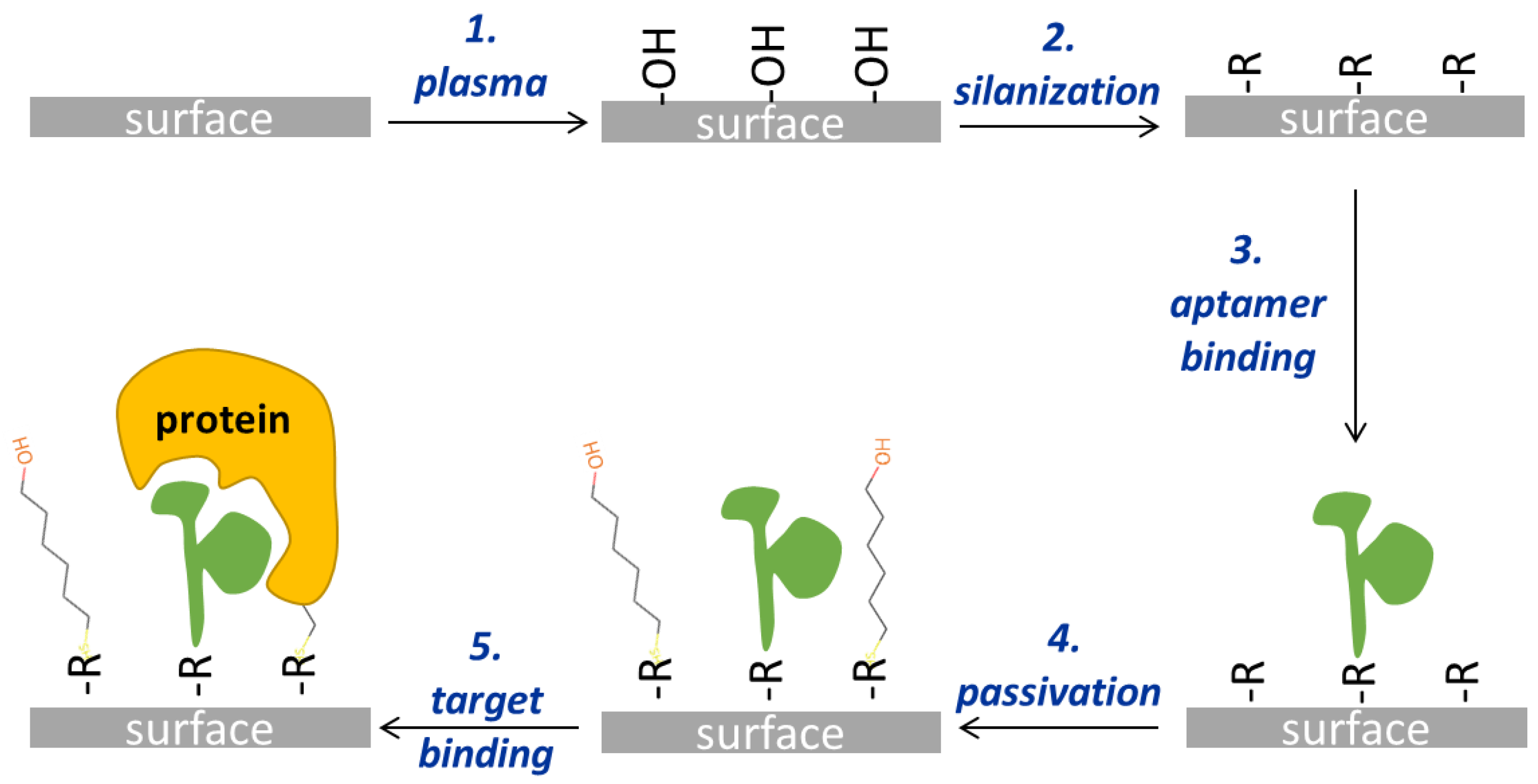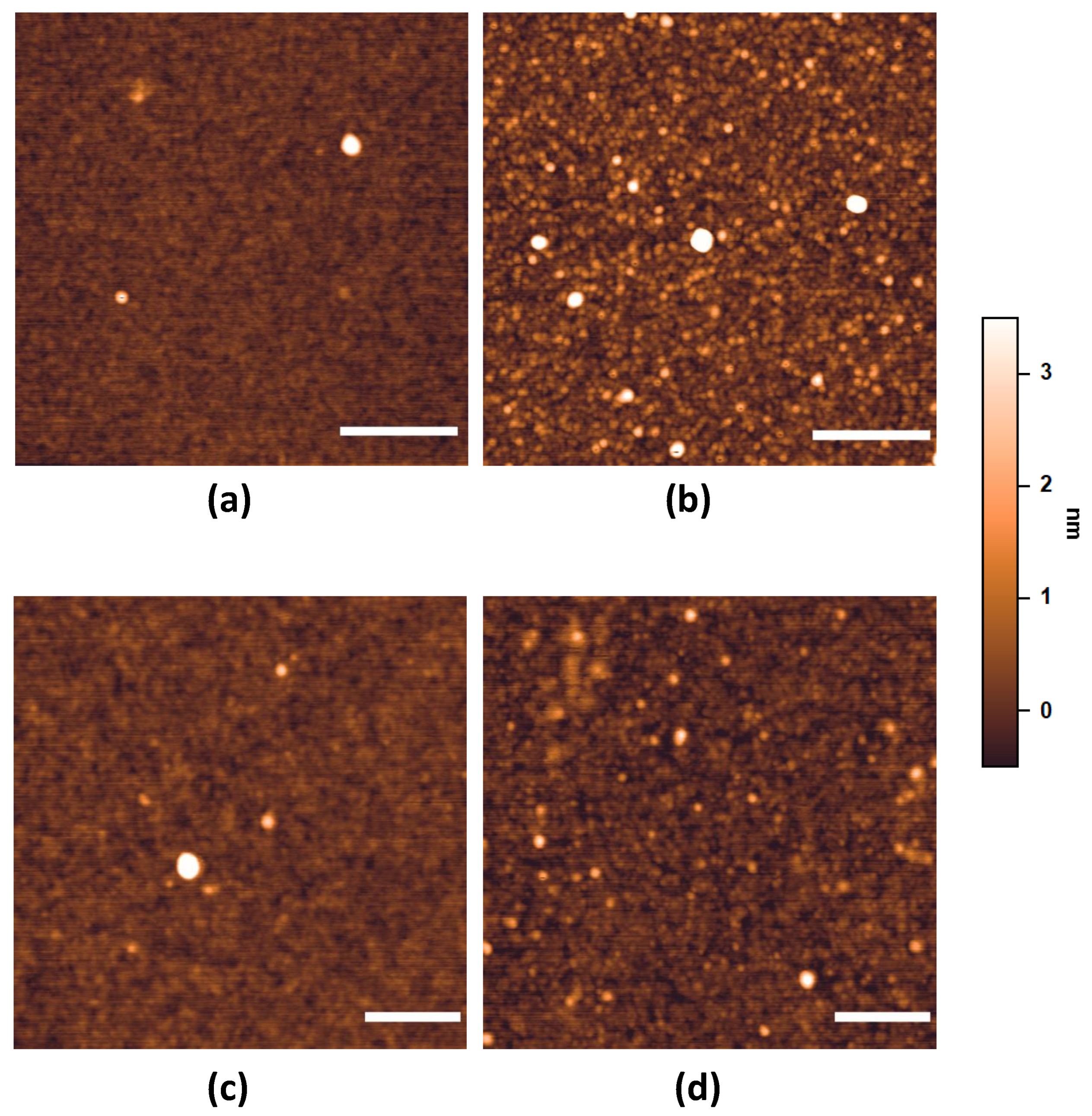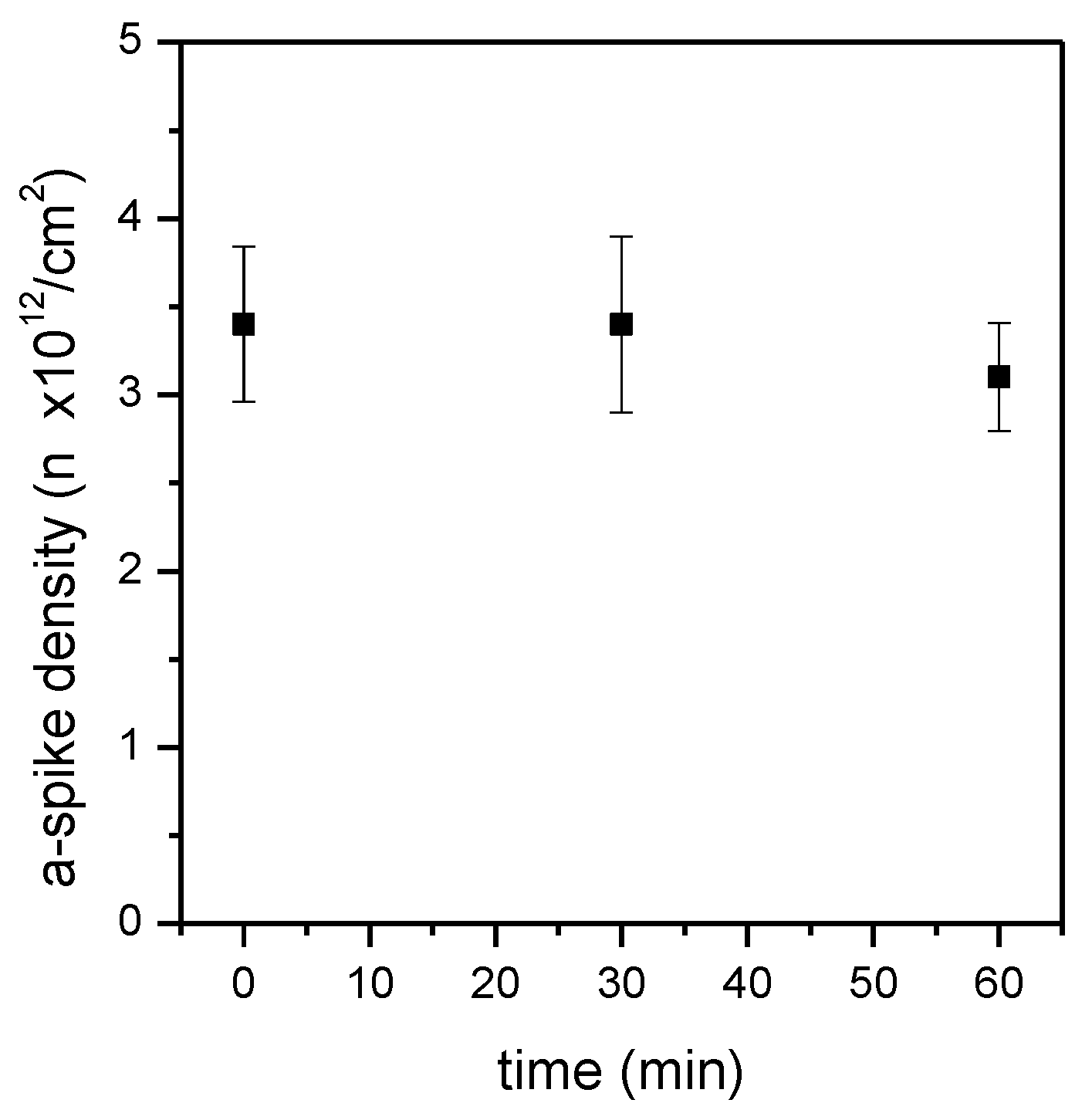Optimization of Surface Functionalizations for Ring Resonator-Based Biosensors
Abstract
1. Introduction
2. Materials and Methods
2.1. Materials
2.2. Setup of the Functionalization Protocol
2.3. Characterization of the Functionalization Steps
2.4. Optical Setup and Measurements
3. Results and Discussion
3.1. Activation of Silicon Surfaces by Plasma Treatments
3.2. Development of the Silanization Protocol
3.3. Binding of Aptamers on the Silanized Surfaces
3.4. Passivation of the Functional Surfaces
3.5. Functionalization Protocol Applied to Photonic Chips
3.6. Measures of Protein Targets with the Optical Setup
4. Conclusions
Supplementary Materials
Author Contributions
Funding
Institutional Review Board Statement
Informed Consent Statement
Data Availability Statement
Conflicts of Interest
References
- Bao, Y.; Zhang, D.; Guo, H.; Ma, W. Beyond blood: Advancing the frontiers of liquid biopsy in oncology and personalized medicine. Cancer Sci. 2024, 115, 1060–1072. [Google Scholar] [CrossRef] [PubMed]
- Braig, Z.V. Personalized medicine: From diagnostic to adaptive. Biomed. J. 2022, 45, 132–142. [Google Scholar] [CrossRef] [PubMed]
- Ignatiadis, M.; Sledge, G.W.; Jeffrey, S.S. Liquid biopsy enters the clinic—Implementation issues and future challenges. Nat. Rev. Clin. Oncol. 2021, 18, 297–312. [Google Scholar] [CrossRef] [PubMed]
- Duque, G.; Manterola, C.; Otzen, T.; Arias, C.; Palacios, D.; Mora, M.; Galindo, B.; Holguín, J.P.; Albarracín, L. Cancer Biomarkers in Liquid Biopsy for Early Detection of Breast Cancer: A Systematic Review. Clin. Med. Insights Oncol. 2022, 16, 117955492211348. [Google Scholar] [CrossRef]
- Patel, A.; Patel, S.; Patel, P.; Tanavde, V.; Tanavde, V. Saliva Based Liquid Biopsies in Head and Neck Cancer: How Far Are We from the Clinic? Front. Oncol. 2022, 12, 828434. [Google Scholar] [CrossRef] [PubMed]
- Napione, L. Integrated Nanomaterials and Nanotechnologies in Lateral Flow Tests for Personalized Medicine Applications. Nanomaterials 2021, 11, 2362. [Google Scholar] [CrossRef] [PubMed]
- Potrich, C.; Palmara, G.; Frascella, F.; Pancheri, L.; Lunelli, L. Innovative Detection of Biomarkers Based on Chemiluminescent Nanoparticles and a Lensless Optical Sensor. Biosensors 2024, 14, 184. [Google Scholar] [CrossRef]
- Pittman, T.W.; Decsi, D.B.; Punyadeera, C.; Henry, C.S. Saliva-based microfluidic point-of-care diagnostic. Theranostics 2023, 13, 1091–1108. [Google Scholar] [CrossRef] [PubMed]
- Tadimety, A.; Closson, A.; Li, C.; Yi, S.; Shen, T.; Zhang, J.X.J. Advances in liquid biopsy on-chip for cancer management: Technologies, biomarkers, and clinical analysis. Crit. Rev. Clin. Lab. Sci. 2018, 55, 140–162. [Google Scholar] [CrossRef]
- Moro, G.; Fratte, C.D.; Normanno, N.; Polo, F.; Cinti, S. Point-of-Care Testing for the Detection of MicroRNAs: Towards Liquid Biopsy on a Chip. Angew. Chem. Int. Ed. 2023, 62, e202309135. [Google Scholar] [CrossRef]
- Liu, J.; Geng, Z.; Fan, Z.; Liu, J.; Chen, H. Point-of-care testing based on smartphone: The current state-of-the-art (2017–2018). Biosens. Bioelectron. 2019, 132, 17–37. [Google Scholar] [CrossRef]
- Haghayegh, F.; Salahandish, R.; Zare, A.; Khalghollah, M.; Sanati-Nezhad, A. Immuno-biosensor on a chip: A self-powered microfluidic-based electrochemical biosensing platform for point-of-care quantification of proteins. Lab Chip 2022, 22, 108–120. [Google Scholar] [CrossRef]
- Lai, Z.X.; Wu, C.C.; Huang, N.T. A Microfluidic Platform with an Embedded Miniaturized Electrochemical Sensor for On-Chip Plasma Extraction Followed by In Situ High-Sensitivity C-Reactive Protein (hs-CRP) Detection. Biosensors 2022, 12, 1163. [Google Scholar] [CrossRef]
- Harpak, N.; Borberg, E.; Raz, A.; Patolsky, F. The “Bloodless” Blood Test: Intradermal Prick Nanoelectronics for the Blood Extraction-Free Multiplex Detection of Protein Biomarkers. ACS Nano 2022, 16, 13800–13813. [Google Scholar] [CrossRef]
- Rho, D.; Breaux, C.; Kim, S. Label-Free Optical Resonator-Based Biosensors. Sensors 2020, 20, 5901. [Google Scholar] [CrossRef] [PubMed]
- Soler, M.; Huertas, C.S.; Lechuga, L.M. Label-free plasmonic biosensors for point-of-care diagnostics: A review. Expert Rev. Mol. Diagn. 2019, 19, 71–81. [Google Scholar] [CrossRef]
- Ciminelli, C.; Campanella, C.M.; Dell’Olio, F.; Campanella, C.E.; Armenise, M.N. Label-free optical resonant sensors for biochemical applications. Prog. Quantum Electron. 2013, 37, 51–107. [Google Scholar] [CrossRef]
- Vollmer, F.; Arnold, S. Whispering-gallery-mode biosensing: Label-free detection down to single molecules. Nat. Methods 2008, 5, 591–596. [Google Scholar] [CrossRef] [PubMed]
- Chalyan, T.; Potrich, C.; Schreuder, E.; Falke, F.; Pasquardini, L.; Pederzolli, C.; Heideman, R.; Pavesi, L. AFM1 Detection in Milk by Fab’ Functionalized Si3N4 Asymmetric Mach-Zehnder Interferometric Biosensors. Toxins 2019, 11, 409. [Google Scholar] [CrossRef]
- Steglich, P.; Rabus, D.G.; Sada, C.; Paul, M.; Weller, M.G.; Mai, C.; Mai, A. Silicon Photonic Micro-Ring Resonators for Chemical and Biological Sensing: A Tutorial. IEEE Sens. J. 2022, 22, 10089–10105. [Google Scholar] [CrossRef]
- Komikawa, T.; Tanaka, M.; Yanai, K.; Johnson, B.R.G.; Critchley, K.; Onodera, T.; Evans, S.D.; Toko, K.; Okochi, M. A bioinspired peptide matrix for the detection of 2,4,6-trinitrotoluene (TNT). Biosens. Bioelectron. 2020, 153, 112030. [Google Scholar] [CrossRef] [PubMed]
- Loyez, M.; Adolphson, M.; Liao, J.; Yang, L. From Whispering Gallery Mode Resonators to Biochemical Sensors. ACS Sens. 2023, 8, 2440–2470. [Google Scholar] [CrossRef]
- Guarisco, M.; Gandolfi, D.; Guider, R.; Vanzetti, L.; Bartali, R.; Ghulinyan, M.; Cretich, M.; Chiari, M.; Bettotti, P.; Pavesi, L.; et al. A new aptamer immobilization strategy for protein recognition. Sens. Actuators B 2017, 252, 222–231. [Google Scholar] [CrossRef]
- Pilvenyte, G.; Ratautaite, V.; Boguzaite, R.; Samukaite-Bubniene, U.; Plausinaitis, D.; Ramanaviciene, A.; Bechelany, M.; Ramanavicius, A. Molecularly imprinted polymers for the recognition of biomarkers of certain neurodegenerative diseases. J. Pharm. Biomed. Anal. 2023, 228, 115343. [Google Scholar] [CrossRef]
- Arnfinnsdottir, N.B.; Chapman, C.A.; Bailey, R.C.; Aksnes, A.; Stokke, B.T. Impact of Silanization Parameters and Antibody Immobilization Strategy on Binding Capacity of Photonic Ring Resonators. Sensors 2020, 20, 3163. [Google Scholar] [CrossRef]
- Wu, B.; Jiang, R.; Wang, Q.; Huang, J.; Yang, X.; Wang, K.; Li, W.; Chen, N.; Li, Q. Detection of C-reactive protein using nanoparticle-enhanced surface plasmon resonance using an aptamer-antibody sandwich assay. Chem. Commun. 2016, 52, 3568–3571. [Google Scholar] [CrossRef]
- Song, Y.; Song, J.; Wei, X.; Huang, M.; Sun, M.; Zhu, L.; Lin, B.; Shen, H.; Zhu, Z.; Yang, C. Discovery of Aptamers Targeting Receptor-Binding Domain of the SARS-CoV-2 Spike Glycoprotein. Anal. Chem. 2020, 92, 9895–9900. [Google Scholar] [CrossRef]
- Tasset, D.M.; Kubik, M.F.; Steiner, W. Oligonucleotide inhibitors of human thrombin that bind distinct epitopes. J. Mol. Biol. 1997, 272, 688–698. [Google Scholar] [CrossRef]
- Schneider, C.A.; Rasband, W.S.; Eliceiri, K.W. NIH Image to ImageJ: 25 years of image analysis. Nat. Methods 2012, 9, 671–675. [Google Scholar] [CrossRef]
- Speranza, G.; Canteri, R. RxpsG a new open project for Photoelectron and Electron Spectroscopy data processing. SoftwareX 2019, 10, 100282. [Google Scholar] [CrossRef]
- Schindelin, J.; Arganda-Carreras, I.; Frise, E.; Kaynig, V.; Longair, M.; Pietzsch, T.; Preibisch, S.; Rueden, C.; Saalfeld, S.; Schmid, B.; et al. Fiji: An open-source platform for biological-image analysis. Nat. Methods 2012, 9, 676–682. [Google Scholar] [CrossRef] [PubMed]
- Elender, G.; Kühner, M.; Sackmann, E. Functionalisation of Si/SiO2 and glass surfaces with ultrathin dextran films and deposition of lipid bilayers. Biosens. Bioelectron. 1996, 11, 565–577. [Google Scholar] [CrossRef] [PubMed]
- Wong, A.K.Y.; Krull, U.J. Surface characterization of 3-glycidoxypropyltrimethoxysilane films on silicon-based substrates. Anal. Bioanal. Chem. 2005, 383, 187–200. [Google Scholar] [CrossRef] [PubMed]
- Senkevich, J.J.; Yang, G.R.; Lu, T.M. Thermal stability of mercaptan terminated self-assembled multilayer films on SiO2 surfaces. Colloids Surf. A Physicochem. Eng. Asp. 2002, 207, 139–145. [Google Scholar] [CrossRef]
- Chen, W.H.; Tseng, Y.T.; Hsieh, S.; Liu, W.C.; Hsieh, C.W.; Wu, C.W.; Huang, C.H.; Lin, H.Y.; Chen, C.W.; Lin, P.Y.; et al. Silanization of solid surfaces via mercaptopropylsilatrane: A new approach of constructing gold colloid monolayers. RSC Adv. 2014, 4, 46527–46535. [Google Scholar] [CrossRef]
- Artusio, F.; Fumagalli, F.; Bañuls-Ciscar, J.; Ceccone, G.; Pisano, R. General and adaptive synthesis protocol for high-quality organosilane self-assembled monolayers as tunable surface chemistry platforms for biochemical applications. Biointerphases 2020, 15, 0410051-12. [Google Scholar] [CrossRef]
- Bass, J.D.; Katz, A. Bifunctional Surface Imprinting of Silica: Thermolytic Synthesis and Characterization of Discrete Thiol-Amine Functional Group Pairs. Chem. Mater. 2006, 18, 1611–1620. [Google Scholar] [CrossRef]
- Santini, G.C.; Potrich, C.; Lunelli, L.; Pasquardini, L.; Vaghi, V.; Pederzolli, C. Innovative microRNA purification based on surface properties modulation. Colloids Surf. B Biointerfaces 2014, 116, 160–168. [Google Scholar] [CrossRef]
- Pasquardini, L.; Lunelli, L.; Potrich, C.; Marocchi, L.; Fiorilli, S.; Vozzi, D.; Vanzetti, L.; Gasparini, P.; Anderle, M.; Pederzolli, C. Organo-silane coated substrates for DNA purification. Appl. Surf. Sci. 2011, 257, 10821–10827. [Google Scholar] [CrossRef]
- Simon, L.; Bognár, Z.; Gyurcsányi, R.E. Finding the Optimal Surface Density of Aptamer Monolayers by SPR Imaging Detection-based Aptamer Microarrays. Electroanalysis 2020, 32, 851–858. [Google Scholar] [CrossRef]
- Rogers, Y.H.; Jiang-Baucom, P.; Huang, Z.J.; Bogdanov, V.; Anderson, S.; Boyce-Jacino, M.T. Immobilization of Oligonucleotides onto a Glass Support via Disulfide Bonds: A Method for Preparation of DNA Microarrays. Anal. Biochem. 1999, 266, 23–30. [Google Scholar] [CrossRef] [PubMed]
- Pasquardini, L.; Pancheri, L.; Potrich, C.; Ferri, A.; Piemonte, C.; Lunelli, L.; Napione, L.; Comunanza, V.; Alvaro, M.; Vanzetti, L.; et al. SPAD aptasensor for the detection of circulating protein biomarkers. Biosens. Bioelectron. 2015, 68, 500–507. [Google Scholar] [CrossRef] [PubMed]
- Pasquardini, L.; Berneschi, S.; Barucci, A.; Cosi, F.; Dallapiccola, R.; Insinna, M.; Lunelli, L.; Conti, G.N.; Pederzolli, C.; Salvadori, S.; et al. Whispering gallery mode aptasensors for detection of blood proteins. J. Biophotonics 2013, 6, 178–187. [Google Scholar] [CrossRef]
- Riccardi, C.; Napolitano, E.; Platella, C.; Musumeci, D.; Montesarchio, D. G-quadruplex-based aptamers targeting human thrombin: Discovery, chemical modifications and antithrombotic effects. Pharmacol. Ther. 2021, 217, 107649. [Google Scholar] [CrossRef]









| Plasma Treatment Name | Gas | Power (W) | Time (min) |
|---|---|---|---|
| p1 | argon | 10.5 | 1 |
| p2 | oxygen | 50 | 2 |
| Surface Name | Plasma Treatment | Silanization Name | Silane | % v/v | Sonication |
|---|---|---|---|---|---|
| p1g1 | p1 | g1 | GPTMS | 1 | - |
| p1g1s | p1 | g1s | GPTMS | 1 | 10’ |
| p1g01 | p1 | g01 | GPTMS | 0.1 | - |
| p1g01s | p1 | g01s | GPTMS | 0.1 | 10’ |
| p2g1 | p2 | g1 | GPTMS | 1 | - |
| p2g1s | p2 | g1s | GPTMS | 1 | 10’ |
| p2g01s | p2 | g01s | GPTMS | 0.1 | 10’ |
| p1m1 | p1 | m1 | MPTMS | 1 | - |
| p1m1s | p1 | m1s | MPTMS | 1 | 10’ |
| p1m01 | p1 | m01 | MPTMS | 0.1 | - |
| p1m01s | p1 | m01s | MPTMS | 0.1 | 10’ |
| p2m1 | p2 | m1 | MPTMS | 1 | - |
| p2m1s | p2 | m1s | MPTMS | 1 | 10’ |
| p2m01 | p2 | m01 | MPTMS | 0.1 | - |
| p2m01s | p2 | m01s | MPTMS | 0.1 | 10’ |
| Name | Sequence (5′–3′) | Target | 5′ Modification | 3′ Modification |
|---|---|---|---|---|
| a-CRP | CGA AGG GGA TTC GAG GGG TGA TTG CGT GCT CCA TTT GGT G | CRP | 5ThioMC6-D/ | /36-TAMSp/ |
| a-spike | CAG CAC CGA CCT TGT GCT TTG GGA GTG CTG GTC CAA GGG CGT TAA TGG ACA | Spike protein | /5AmMC12/; /5ThioMC6-D/ | /36-TAMSp/ |
| a-Thr | AG TCC GTG GTA GGG CAG GTT GGG GTG ACT | Thrombin | /5ThioMC6-D/ | |
| NS | ATC TAC GAA TTC ATC AGG | - | /5ThioMC6-D/ |
| Elemental Composition | ||||
|---|---|---|---|---|
| Surfaces | O % | C % | Si % | Roughness (nm) |
| p1 | 31.1 | - | 68.9 | 0.24 ± 0.04 |
| p2 | 41.1 | 5.3 | 53.6 | |
| Surface | Elemental Composition | Roughness | Contact Angle | Thiol Density | |||
|---|---|---|---|---|---|---|---|
| (GPTMS) | O % | C % | Si % | S (%) | (nm) | (°) | (n × 1014/cm2) |
| p1g1 | 3.6 ± 2.8 | 57.3 ± 1.1 | - | ||||
| p1g1s | 30.6 | 22.4 | 47.0 | - | 0.7 ± 0.1 | 58.0 ± 1.2 | - |
| p1g01 | 31.7 | 18.0 | 50.3 | - | 0.7 ± 0.1 | 62.6 ± 2.0 | - |
| p1g01s | 30.9 | 19.5 | 49.6 | - | 0.35 ± 0.03 | 52.5 ± 0.7 | - |
| p2g1 | 47.5 | 15.3 | 37.2 | 1.1 ± 0.7 | 55.7 ± 1.3 | - | |
| p2g1s | 37.0 | 20.1 | 42.9 | - | 0.50 ± 0.04 | 52.2 ± 0.7 | - |
| p2g01s | 36.3 | 21.5 | 42.2 | - | 0.43 ± 0.03 | 52.0 ± 1.1 | - |
| (MPTMS) | |||||||
| p1m1 | 29.3 | 15.7 | 52.4 | 2.6 | 0.70 ± 0.06 | 60.1 ± 2.3 | 4.0 ± 0.9 |
| p1m1s | 29.8 | 15.9 | 52.8 | 1.5 | 0.9 ± 0.1 | 46.0 ± 2.7 | 3.6 ± 0.2 |
| p1m01 | 1.1 | ||||||
| p1m01s | 28.7 | 13.2 | 56.1 | 2.0 | 0.61 ± 0.06 | 44.6 ± 2.3 | 0.5 |
| p2m1 | 60.2 ± 2.1 | 4.2 ± 0.6 | |||||
| p2m1s | 35.6 | 15.5 | 45.6 | 3.3 | 0.82 ± 0.07 | 45.8 ± 2.5 | 2.5 ± 0.5 |
| p2m01 | 1.0 | ||||||
| p2m01s | 36.0 | 14.0 | 48.5 | 1.5 | 0.7 ± 0.1 | 45.3 ± 1.0 | 0.2 |
Disclaimer/Publisher’s Note: The statements, opinions and data contained in all publications are solely those of the individual author(s) and contributor(s) and not of MDPI and/or the editor(s). MDPI and/or the editor(s) disclaim responsibility for any injury to people or property resulting from any ideas, methods, instructions or products referred to in the content. |
© 2024 by the authors. Licensee MDPI, Basel, Switzerland. This article is an open access article distributed under the terms and conditions of the Creative Commons Attribution (CC BY) license (https://creativecommons.org/licenses/by/4.0/).
Share and Cite
Ardoino, N.; Lunelli, L.; Pucker, G.; Vanzetti, L.; Favaretto, R.; Pasquardini, L.; Pederzolli, C.; Guardiani, C.; Potrich, C. Optimization of Surface Functionalizations for Ring Resonator-Based Biosensors. Sensors 2024, 24, 3107. https://doi.org/10.3390/s24103107
Ardoino N, Lunelli L, Pucker G, Vanzetti L, Favaretto R, Pasquardini L, Pederzolli C, Guardiani C, Potrich C. Optimization of Surface Functionalizations for Ring Resonator-Based Biosensors. Sensors. 2024; 24(10):3107. https://doi.org/10.3390/s24103107
Chicago/Turabian StyleArdoino, Niccolò, Lorenzo Lunelli, Georg Pucker, Lia Vanzetti, Rachele Favaretto, Laura Pasquardini, Cecilia Pederzolli, Carlo Guardiani, and Cristina Potrich. 2024. "Optimization of Surface Functionalizations for Ring Resonator-Based Biosensors" Sensors 24, no. 10: 3107. https://doi.org/10.3390/s24103107
APA StyleArdoino, N., Lunelli, L., Pucker, G., Vanzetti, L., Favaretto, R., Pasquardini, L., Pederzolli, C., Guardiani, C., & Potrich, C. (2024). Optimization of Surface Functionalizations for Ring Resonator-Based Biosensors. Sensors, 24(10), 3107. https://doi.org/10.3390/s24103107









